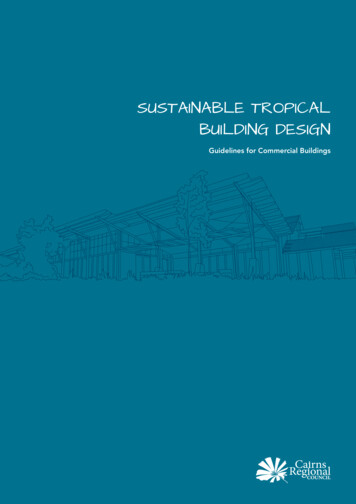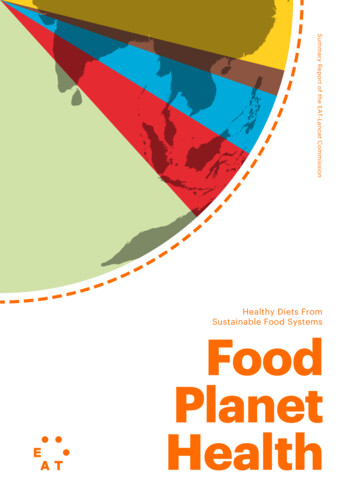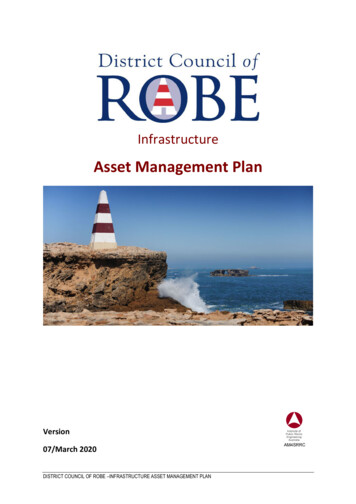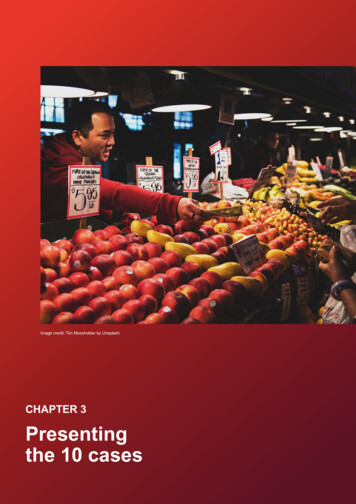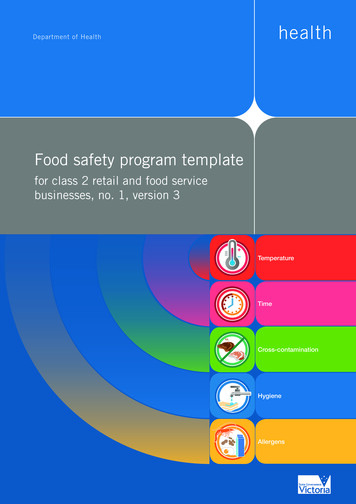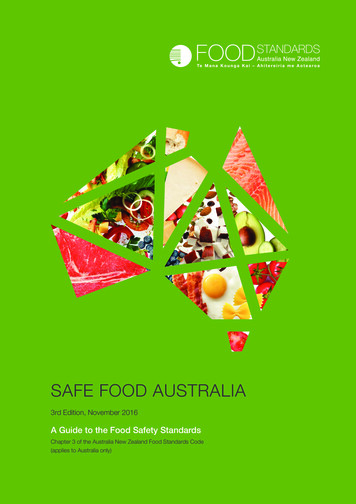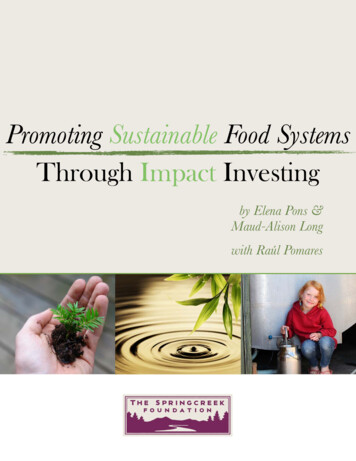
Transcription
Promoting Sustainable Food SystemsThrough Impact Investingby Elena Pons &Maud-Alison Longwith Raúl Pomares
About The Springcreek FoundationDisclosureThe information presented herein has been prepared for informational purposes only and isnot an offer to buy or sell, or a solicitation of an offer to buy or sell, any security or fundinterest. The offering circular of each security or the respective fund’s confidential offeringmemorandum contains important information concerning risks and other material aspects ofthe investment and must be read carefully before a decision to invest is made.Although the information presented herein has been obtained from and is based upon sourceswe believe to be reliable, no representation or warranty, express or implied, is made as to theaccuracy or completeness of that information. No assurance can be given that the investmentobjectives described herein will be achieved.The Springcreek Foundation does not provide tax, financial or legal advice and individuals orinstitutions are strongly urged to consult with their tax, financial or legal advisors regarding anypotential decision regarding their investments and or their philanthropy. The material containedin this publication is for informational purposes only. The material is based upon informationwhich we consider reliable, but we do not present that such information is accurate orcomplete, and it should not be relied upon as such.
Table of ContentsForeword . iAcknowledgements . iiAbout The Springcreek Foundation . iiiExecutive Summary . 1Report ObjectivesWhy is this research needed?A Case Study ApproachWhat is Impact Investing? . 3What Are Sustainable Food Systems and Why Are They Important? . 4Smaller and Smaller. (Figure1)World Food & Oil Prices (Figure 2)What are the Challenges of Investing in Sustainable Food Systems? . 9Main Findings . 11Current Farm FinancingOpportunities for Accredited and Retail InvestorsCatalyzed Investor InterestInnovative Investment OpportunitiesRegional Public-Private Partnership InitiativesFood Hubs and Local Urban DistributionInvestment Opportunities in Sustainable / Organic FarmlandLayered Investment StructuresDonor InvolvementConclusion . 18Case Studies . 20MethodologyInvestment Allocation Matrix (Figure 3)Case Studies by Geography (Figure 4)Case StudiesAppendix A . 47Appendix B . 49Appendix C . 50
About The Springcreek FoundationForewordOpportunities to invest in domestic sustainable food and agriculture have grown dramatically inthe last decade. There now exists a vibrant ecosystem of investors, philanthropists, policymakers, food producers & processors, and advocacy groups, all in tireless pursuit of a solution.At one time, our land abounded with flourishing agrarian communities. These were not withoutfailure and strife, but the underlying structures and intentions were pure. Human intelligenceevolved these concepts of cultivation, nourishment and growth into the financial world,developing communities and tools to further our prosperity.We now have the history and the experience to see how people, planet and profit interact; thisperspective yields both insight and profound responsibility. As investors, it is incumbent upon usto leverage our unique role in the marketplace, and position the investment industry for positivesocial change. A focus on sustainable food and farming is as essential as nourishment is to life.It integrates air, water, land, and communities. Our health and welfare as humans – and for alllife on the planet - demand that we now carefully and expertly wield our innate intelligence, fromthe most basic to the most complex. We must link “philanthropy” - our love for our own kind - toour propensity for industry and innovation. Our instinct to not only survive, but also flourish, hasyielded intelligence and tools that are now called to action.Promoting Sustainable Food Systems through Impact Investing aims to provide aframework through which investors can play a critical role in the establishment and maintenanceof regional sustainable food systems in the United States. These new systems will improve ourair, our water, our land, and the health of our selves and our communities. However, investmentopportunities in these systems must be designed - they will not manifest without our purposefulaction. While there are early signs of infrastructure - products and ideas with the potential tocreate more opportunities and greater impact - the market remains vulnerable: in order to attainscalability, all stakeholders must uphold a common goal.The growth in demand for sustainably produced, processed, and distributed products is gainingmomentum, making investments in sustainable food and agriculture a viable option for impactinvestors. The diversity inherent to the field of food and agriculture lends itself ideally to a rangeof interests and risk appetites. Pioneering investors are evolving the field through the use ofnew, multi-layered vehicles that create measurable social and environmental impact. But at TheSpringcreek Foundation, our mission is not to grow the field of investment opportunities; it is toleverage investments as a critical tool towards the reform of the current, industrialized foodsystem, and lead the way to sustainable, regional food systems that provide healthier food, air,water, land, people, and communities.We invite you to exercise your right to choose – as a consumer, investor and citizen of theworld. The simple insistence upon fresh, uncompromised, nutrient-rich food produced inharmony with the environment represents the most likely chance of a healthy and prosperouslife for ourselves, our children, and future generations.Maud-Alison LongPresidentThe Springcreek Foundation
About The Springcreek FoundationAcknowledgementsThe authors wish to thank everyone who helped inform and inspire this publication. Thisreport would not have been possible without their invaluable input and support.Ricardo Bayon, Partner, EKO Asset Management PartnersSusan Clark, Executive Director, Columbia FoundationMichael Dimock, President, Roots of ChangeOran B. Hesterman, President & CEO, Fair Food NetworkChris Larson, Director of Real Assets and Sustainable Agriculture, New Island CapitalLaetitia Mailhes, Journalist, The Green Plate BlogGreg Ostroff, Private InvestorWoody Tasch, Chairman and Founder, Slow MoneyFinally, this report was beautifully designed and produced by Grayson Bass.Thank you,The Authors
About The Springcreek FoundationAbout The Springcreek FoundationThe Springcreek Foundation (TSF) is a private foundation founded in 1994 by theCorning and Long families to continue and expand their tradition of philanthropy andresponsible investing. The foundationnow strategically leverages the family’s sixgenerations of expertise in investment management to enhance their charitableimpact. While Donor Advised Funds support the expression of individual philanthropyand collaborative grant-making, impact investing is now the foundation’s core strategyto advance a conservation economy.Representing the sixth generation of family stewardship, Maud-Alison Long, President,and Marlis Corning Jansen, Vice President, have lead the foundation to a timely albeitlofty goal: Food System Reform. As mothers and community members, Ms. Long andMrs. Jansen saw a growing need for both education about and access to healthy foodin Marin County and beyond; this awareness coincided with the realization that ourcounty also boasts some of the most abundant food and food education in the country.But the question remained of how could such abundance represent, in actuality, sucha tragically broken system?
Executive Summary“.why is it that anindustrialized system,deeply dependent on fossilfuels and chemicaltreatments, is promoted asviable while a much lessdamaging one is rubbishedand condemned as unfit forpurpose?”Prince of Wales, speech atReport ObjectivesTrue to its mission of supporting a conservation economy, and consciousof the tremendous public health, social, environmental, and economicimplications of industrial agribusiness1, TSF has endeavored to develop aframework through which one can better understand the landscape ofcurrent and emerging impact investing opportunities which will ultimatelyaid in the reform of the domestic food system2. This report is designedfor the investment community: foundations, funds, high net worthindividuals, financial advisors, wealth managers, family offices,institutional investors, and other stakeholders. The primary goal is toinform impact investors about the current state of this industry, and tosupport impact investors’ capacity to catalyze high-impact social,environmental and economic change.Future of FoodConference, WashingtonWhy is this research needed?D.C., May 2011The topic of sustainable food and agriculture has triggered mountinginterest from impact investors in recent years. Some investors have evenbegun to explore opportunities in sustainable food systems by investing in innovation or greenconsumer products. Yet the flow of capital into this investment area remains disappointingly low,and appears arbitrary. Until recently, sustainable food systems funding has been limited toinsufficient government and charitable support. Donations and grants have played - and willcontinue to play - a critical role in the reform of the existing food system; however, acomprehensive food system reform requires the participation of for-profit investors. Given thepaucity of currently available data relevant to impact investing in sustainable food systems, thisreport aims to provide a better understanding of the emerging investment opportunities in thesector by identifying current trends and featuring examples of high-impact investmentopportunities.A Case Study ApproachProfiled below are case studies of high impact investment opportunities collected from investorswith diverse investment goals. TSF has developed a framework to use when considering aninvestment opportunity to ensure it has high impact pactInvesting1
Investments that target these leverage points willachieve greater and faster impact.This framework applies a lens deduced from the work of Roots of Change (ROC)3, a Californiabased nonprofit sustainable food systems advocacy group, whose mission is to transition Californiato a sustainable food system by 2030. After building consensus among 35 stakeholders in ourcurrent food system, ROC created a systems dynamic map that demonstrates critical points ofleverage that will produce the most significant and measurable progress toward sustainability (seeMethodology section on page 20 for description of ROC's systems dynamic map). Thus,investments that target these leverage points will achieve greater and faster impact. By furtherrefining and tailoring the work of ROC, our framework offers investors a basis for discussion andimplementation of impact investments that support more sustainable food systems. Furthermore,as represented in the Investment Allocation Matrix in page 21, the case studies have beenorganized by the issue area(s) they address. The five (5) main issue areas are: air, water, land,health and community development. The social, environmental and financial impact of eachinvestment opportunity is described thoroughly in each case study.We acknowledge that food and farming is a dynamic space; therefore welcome your feedback forinclusion in future publications, and invite you to collaborate with us in moving the sector ctInvesting2
What is Impact Investing?Impactinvestments worklike any otherinvestment, withjust one addedmeasurablecomponent:By engaging the private sector in an investment area that traditionally hasbeen limited to philanthropy, impact investing aims to provideenvironmental, social and governance solutions at scale.It has been designed to leverage significant capital and expertise againstthe world’s most pressing challenges. Impact investing, also referred to associal investing, sustainable investing, mission investing, and impact finance, hasbeen defined as “any investment activity that purposefullygenerates measurable public benefit” 4. The goal of impact investmentsis to significantly contribute to poverty alleviation, social growth,the Impact.economic development and environmental preservation. Traditionalimpact investors are high-net-worth individuals, institutional investors,corporations, religious groups, and foundations; however due to theincreasing awareness and expanding investment options, some retail investors have recently begun toparticipate in this growing industry. Investments are typically made through an investment vehiclesuch as an investment fund; sometimes, however, they are made directly to organizations. Impactinvestments work like any other investment, with just one added measurable component: the Impact.As with the investment industry at large, impact investments constitute a vast marketplace with diversefinancial products, ranging from a cash deposit in a community bank that finances local sustainablebusinesses in Vermont, a debt loan to a social college fund that finances low-income students inCalifornia, a real asset investment through a fund working on restoring ranch and farm land inMontana, or an equity investment in an initiative to provide affordable home solar power systems inNew Orleans. Impact investments not only provide the foundation for a more sustainable andequitable economy, but they also allow investors to diversify greatly across impact areas, geographiesand asset classes; the trademark of a fiscally responsible investment profile.Central to impact investing is the motivation and intention of the investor. The terms Impact First /Financial First investor were coined by the Monitor Institute in 2009. According to this researchgroup specializing in social change, Impact First investors seek to optimize social or environmentalreturn with a financial floor; Financial First investors seek to optimize financial returns with an impactfloor5. The question is, if there were no impact, would that particular investor still invest? If so, he/she is a Financial First investor; if not, he/she is an Impact First investor. Some investors may havewide-ranging portfolios that touch on different approaches in different investments. Thus, the sameinvestor may have deals that fall into both Financial First and Impact First categories, depending ontheir primary motivation for that particular Investing3
What Are Sustainable Food Systemsand Why Are They Important?Sustainable food systems reflect a structure andprocess that create a close link between theproducers and the consumers of food, such that thehealth of people, place, planet & profit are optimallyrestored and supported. Sustainable food systemsinclude all the major points along the food supplychain (production, processing, distribution, andconsumption) and have the potential to solve manyof the world’s pressing social, health, andenvironmental challenges.A broken food system in the US and around theworld has significantly contributed to five (5)important “tragedies”: environmental pollution,water pollution, land and soil degradation, public health damage, and community collapse. Thepollution of the environment and the water is a serious matter. According to a recent study fromScientific American7, agribusiness is responsible for one third of human-induced globalgreenhouse gas emissions. Especially alarming are the levels of nitrogen and methane emissions.Current practices for food production, processing and distribution use technology powered bygasoline, diesel and natural gas, which results in air and water pollution, depletion of soil fertility,and a reduction of species diversity. As indicated by the National Sustainable AgricultureInformation Service, on average, produce in the U.S. travels 1,300 – 2,000 miles between farm andconsumer.Similarly, human activities have degraded or destroyed the quality and productivity of soil. Theamount of arable, productive land is decreasing at alarming rates. According to the WorldResources Institute, the main causes of soil degradation in the US are agricultural activities,overgrazing and deforestation. The majority of today’s farm owners don’t have access to the capitalneeded to maintain their permanent cropland. As a result, fertile land is being sold to developersand large agribusinesses that use environmentally degrading practices.Current food production and processing practices have created a record number of cases ofobesity and cardiovascular diseases in the United States. According to PolicyLink, a nationalresearch and action institute advancing economic and social equity, 30.5 percent of children inages 10-17 are obese in the United States. Similarly, a recent article in the Journal of the AmericanMedical Association predicts that a child born since the year 2000 has a one-in-three chance ofdeveloping diabetes; minority children have a staggering one-in-two tInvesting4
Many low-income neighborhoods do not have access to fruits, vegetables, whole grains and theother foods that compose a healthy, well-balanced diet; instead communities are populated by fastfood restaurants and convenience stores selling high-fat, high-sugar, highly processed andchemically preserved foods. Fresh food is either not available or not affordable. These areas areknown as food deserts8. Approximately 23.5 million Americans are living in food deserts, most ofwhich exist in urban areas 9.Community development and livability have also been severely impacted by the current foodsystem. The large scale, resource-intensive practices of agribusinesses and corporations aresqueezing small farms and other small food-related businesses out of the market. This “communitycollapse” is a significant concern in farming and food production, as it has resulted in sluggish ruraldevelopment, a lack of incentives for small farmers, and alarmingly few available farmers. In theUS today there are approximately 2,000,000 farmers - less than 1 percent of the population 10.Half of these farmers are likely to retire in the next decade, and very few young people are enteringthe industry to take their places. Farming is extremely physically demanding, and young peoplehave little to draw them to the work. According to a USDA study, the percentage of the food dollarthat stays on the farm has been in decline since the 1950s and is still very low, and most small- tomid-size farmers cannot survive with on-farm income only (Fig. otingSustainableFoodSystemsThroughImpactInvesting5
Regional sustainable food systems are a powerful catalyst of local economy. According to theNew Economics Foundation in London, every dollar spent locally generates twice as much incomefor the local economy. When consumers buy imported goods, money leaves the community atevery transaction.Yet another consequence of the industrialization of food production and community collapse isthe rise in food prices. Between 2006 and 2008 average global food prices increased by 217percent for rice, 136 percent for wheat, 125 percent for corn and 107 percent for soybeans, posinga serious threat to food security11. According to the USDA, in 2009, 14.7 percent of U.S.households were food insecure intermittently during that year, and 3.1 million Californians (about10 percent) did not have enough to eat12. Worldwide, approximately 852 million people arechronically hungry due to extreme poverty13. The International Medical Corps reports that, globalmalnutrition has a higher death toll than HIV, tuberculosis and malaria combined14. Soaring foodprices, which ultimately lead to food insecurity, are mostly due to rising oil prices (Fig. 2); othercontributing factors are global population growth, climate change, loss of agricultural land toresidential and industrial development, growing consumer demand in China and India, andincreased allocation of crops to biofuel temsThroughImpactInvesting6
“We do not fully comprehend that food production is abiological activity and that healthy food is the key tohealthy people. Farms and ranches cannot successfullyoperate as assembly lines for long. we cannot producefood like it is some sort of input for a machine. Food is notgasoline The national health crisis reflects ourmisunderstanding of food. Much of the climate change,water and other pollution crises reflect ourmisunderstanding of agriculture. So I am most concernedwith how we think and how we create systems based on thatthinking.”Michael Dimock, President of Roots of Change15
We have entered an era in which the world must produce morewith less. As the population is expected to reach 9 billion by 2050– with a projected 70 percent urban demographic16 - the need foreffective food production, processing and especially distributionhas intensified. Food systems must become more environmentallysustainable and feed more people. Moreover, an increasedpurchasing power of a growing middle class requires higher qualityand resource-intensive foods, such as meat and dairy. Expertsestimate that annual meat production must rise by 75 percent – to470 million tons – by 2050. Simultaneously, climate change affectsagriculture - changing rainfall patterns and fluctuations intemperature affect crop yields.Current food and agriculture practices, however, have left theplanet in a true systemic food crisis. In an effort to dispute theclaim that chemical-intensive agriculture is the answer to feed theworld, experts at a recent UN panel created the term agroecology.According to these experts, using agroecological techniques agroforestry17, biological control of pests and diseases through theuse of natural predators, water harvesting methods, intercropping,green manure cover crops, mixed crops, livestock management,etc- produces sufficient amounts of food while polluting less.18Regional sustainable food systems will ensure, among otherthings, the long-term productivity and management of existingnatural resources, improved public and environmental health,economic viability, community development, food security, jobcreation, and mainstream awareness and pactInvesting8
What are the Challenges of Investing inSustainable Food Systems?At first glance, investors in sustainable food systems are faced with the traditional challengescharacteristic of impact investing, which include a vast array of investment options across assetclasses, impact areas, and return profiles, as well as lack of deal flow and a limited track record.And, by nature, impact investments in sustainable food and agriculture bear additional challenges.Unpredictable and inclement weather creates inherent risk. In the Midwestern cornbelt, forexample, 49 straight days of rain brought the Mississippi River up to record levels, creating one ofthe largest floods in history. River traffic was halted for 600 miles, 15 million acres of farmland ineight states were flooded, and 36,000 people were forced from their homes, all resulting in billionsof dollars in damage.Another impediment to investments in this space is the current agricultural policy in the UnitedStates. The existing agricultural industry is comprised of a few disproportionately large companieswith excessive political influence and leverage. As mandated by the 2008 Farm Bill, agribusinesseswere the recipients of approximately 43 billion (14 percent of the total 2008 Farm Bill) insubsidies for rice, cotton, corn, soybeans and other commodity crops. These subventions intend tosupplement the income of farmers and others involved in large-scale production of crops byinsuring farmers’ jobs and profitability, yet current agricultural policy has a lasting negative impacton both domestic affairs and the world market. Scale in agribusiness is attained by intensive use ofland, water, fossil fuels, pesticides, herbicides, antibiotics and genetic technology. Such practicesreduce the quality of the product; increase the healthrisks of the consumers, the farm workers, and theenvironment; contribute to ecological destruction; andbreed wealth inequality. In addition to that, agriculturalsubsidies have lasting repercussions on global trade,making it impossible for unregulated countries to bringtheir products to the market place. This marketdistortion both illustrates the harmful potential of acomplex supply chain from seed to table, andemphasizes the importance of an immediate transitionto a sustainable food production economy.The transition to a sustainable food system is asystemic issue and must be treated as such. Policyadvocacy groups in the US denounce the term FarmBill as a misnomer, as, they suggest it should be calledthe “Food and Farm Bill”. By limiting the name to“farm”, it is easier to maintain subsidies that benefit thelarge-scale intensive farmers and it ignores that thelargest portion of the bill in dollar terms ImpactInvesting9
80 billion/year) is for nutrition assistance programs that provide financial support to low-incomepeople for the purchase of food. Policy reform organizations play a critical role in influencingCongress, state and local governments, and designing a road map to new food systems.If we are to advance toward a more sustainable system, consumer behavior must change. Anoverall shift in consumption habits is critical and can only be achieved through education andbuilding awareness. This change is happening rapidly when it comes to organic food20. Accordingto data from the Organic Trade Association, sales of organic food have increased by 20% everyyear since 1990, and three-quarters of the nation’s grocery stores now carry at least some organicfood. Simultaneously, Locally-Grown food is reportedly the fastest growing segment in grocery,and the number of farmers’ markets nationwide has tripled since the mid 90’s21. However one ofthe main impediments to behavior changes in consumers is relatively high price of sustainable/organic fresh food. Due to subsidies and the externalization of social and environmental costs bylarge scale industrial agriculture, small and mid-size organic producers cannot compete solely onprice. One of the objectives of the Food System Reform is to make fresh and nutritious food moreaccessible and affordable for everyone.The unpredictable aspects of the food system outlined above– weather, agribusiness, policy,consumer behavior - increase the perception of risk and deter impact investors, who insteadchoose more established impact investment areas - clean energy, green real estate and otherconservation economy opportunities. While we do not claim to have the solution to these issues,we humbly seek to help organize the fragmented industry by:A) offering a summary of current trends and opportunities in investments in sustainable foodsystems,B) creating a framework to use when considering investment opportunities, andC) providing examples of existing investments that could lead to a substantial impact on thesustainable food and agriculture value Investing10
Main FindingsFoundations and governmental organizations have greatly contributed to the restoration of asustainable food system in past decades; however, charitable donations alone do not have thecapacity to solve critical social and environmental challenges at scale. In order to achieve asystemic transformation in the food system, grant dollars must be combined with investmentdollars.Many US investors have begun to explore impact investing through domestic communitydevelopment projects or microfinance in developing countries. Very few investors have venturedinto the sustainable food and agriculture realm. Compared to other impact investments themes,sustainable food and agriculture is in a nascent stage. However, our research revealed that inactuality, investment opportunities in sustainable food and farming are abundant, and suitable todiverse investment preferences and risk appetites. Following is a summary of TSF’s main findingson domestic investment opportunities in sustainable food
Impact investing, also referred to as social investing, sustainable investing, mission investing, and impact finance, has been defined as "any investment activity that purposefully generates measurable public benefit" 4. The goal of impact investments is to significantly contribute to poverty alleviation, social growth,




